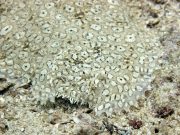Diving with Lefteye Flounders
Lanta Marine Life | Bothidae
Lefteye flounders are a family of very flat fish which lie on the seafloor on their right sides, with both their eyes on their left sides. It is possible, but highly rare, that this is reversed in some specimens.
Always present, but not easy to find when diving Koh Lanta.
This family is also noted for having spines near the eyes and on the snout. Some species have tentacles on the eyes. Species size varies from 4.5 cm up to 88 cm.
Noticeably, there are no spines in the fins, all of the fins are soft rays. The dorsal fin starts above the upper eye. The anus is located on the bottom 'blind' side of the fish.
The eye side of lefteye flounders usually has spots, blotches or rings, with the blind side being usually a light colour (except a dark colour for males in a limited few species). These fish are predators of bottom-dwelling invertebrates and small fish.
1 species found on this page:
Leopard Flounder
(Bothus pantherinus)

Bothus pantherinus @ Koh Haa
The Leopard Flounder has a greyish body with many dark-edged pale spots, some with dark spots at the center. There are a few small dark blotches randomly scattered on the body.
The eyes are close together, about one eye-width apart, and nearly aligned with each other. This is a well camouflaged species.
The Leopard Flounder grows to 39 cm but more often observed in the 15 cm - 20 cm range. This species is found on the sand, especially outside The Lagoon at Koh Haa.
Diving with Lefteye Flounders around Koh Lanta
Scuba Diving & Snorkel Trips
If you'd love a chance to spot Lefteye Flounders on one of our daily high season diving trips from Koh Lanta then send us an email to info@diveandrelax.com.
Join our high season speedboat dive trips to some of Thailand's best dive sites and enjoy small groups, short journey times, with a focus on great personal service, safety and fun.
Not yet a certified diver? Learn to Scuba Dive on Koh Lanta with the 3 day SSI Open Water Diver course.
Book online to save 10% on dive trips and scuba courses on Koh Lanta.
Find Out More
Indo-Pacific Marine Life Guides
- Allen, G., Steene, R., Humann, P., DeLoach, N. (2003) Reef Fish Identification, Tropical Pacific. Jacksonville, FL., USA: New World Publications, Inc., ISBN 1-878348-36-1.
- Humann, P., DeLoach, N., (2010) Reef Creature Identification, Tropical Pacific. Jacksonville, FL., USA: New World Publications Inc., ISBN 978-1-878348-44-9
- Debelius, H. (2013) Indian Ocean Reef Guide. Frankfurt, Germany: IKAN - Unterwasserarchiv, ISBN 978-3-939767-52-7.
- Debelius, H. (2004) Nudibranchs and Sea Snails, Indo-Pacific Field Guide. Frankfurt, Germany: IKAN - Unterwasserarchiv, ISBN 3-925919-51-1
- Erhardt, H., Knop, D. (2015) Corals Indo-Pacific Field Guide. Frankfurt, Germany: IKAN - Unterwasserarchiv, ISBN 3-925919-69-4.
- Veron J.E.N., Stafford-Smith M.G., Turak E. and DeVantier L.M. (2016). Corals of the World
